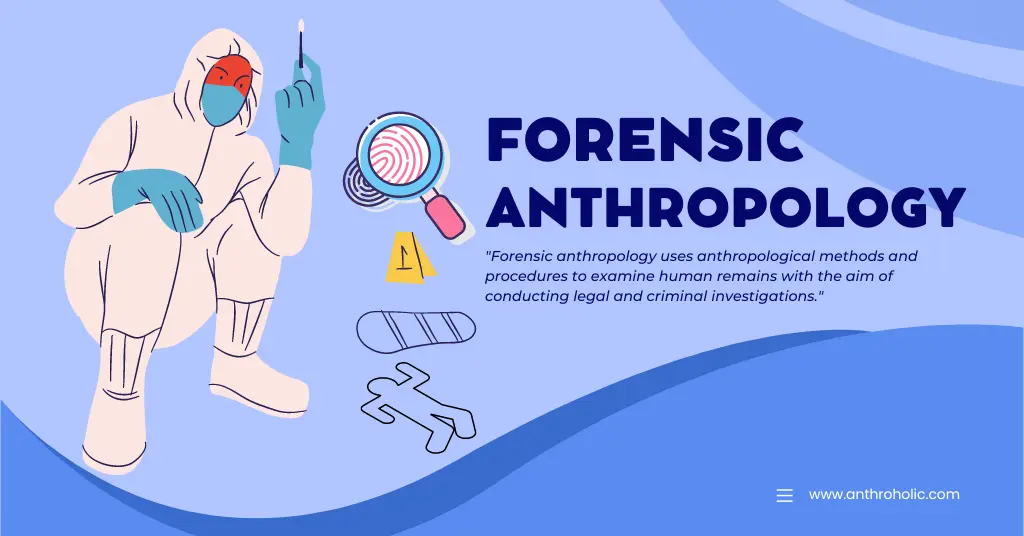AI Answer Evaluation Platform Live Now. Try Free Answer Evaluation Now
Forensic Anthropology
Forensic anthropology uses anthropological methods and procedures to examine human remains with the aim of conducting legal and criminal investigations. Skeletal remains are examined in this area of research to learn details about the deceased person, such as their age, sex, ancestry, height, and mode of death. Besides attempting to identify the person from the remains, forensic anthropologists may provide professional testimony in court situations.

Forensic anthropologists work closely with law enforcement authorities, coroners, and other forensic specialists to support the investigation of crimes and the victimization of victims. They use a range of techniques, including DNA analysis, dental record research, and bone structure and morphology studies. In addition to human bones, forensic anthropologists may also look at other kinds of evidence, such as clothing, jewelry, and personal items discovered alongside the remains.
The discipline of forensic anthropology has become more well-known in recent years because of advancements in DNA technology and other forensic procedures. It is often used to aid in the identification of victims of tragedies, such as natural disasters and terrorist attacks, and victims of historical occurrences, such as wars or mass graves from previous conflicts.
Initial case studies of forensic anthropology’s development over time In the middle of the 19th century, when doctors began examining skeletal remains to identify the deceased and determine the cause of death, the study of forensic anthropology emerged. One of the first instances of the use of forensic anthropology was the investigation of the Countess of Eglinton’s skeletal remains in Scotland in 1830. (2008) Dirkmaat and Adovasio Techniques: “In the early 20th century, forensic anthropology made significant strides, including the introduction of novel techniques for studying skeletal remains. T. Wingate Todd, a physical anthropologist, developed a method for determining age based on bone development. (2011) Passalacqua & Christensen
- World War II: “Forensic anthropologists were called upon to identify the bodies of troops who had been killed in battle during World War II, underscoring the field’s applicability. As a result, new techniques for identifying people from their skeletal remains were developed, such as facial reconstruction and dental information (Byers, 2011).
- Origins as a science: “In the 1970s, forensic anthropology started to take shape as a unique subject thanks to the founding of the American Academy of Forensic Sciences’ (AAFS) Anthropology section in 1972. This contributed to the procedures and methods in the area being more uniform. advancements in DNA analysis: “In the 1980s and 1990s, advancements in DNA analysis changed forensic anthropology by allowing more precise identification of individuals based on biological materials. DNA testing has grown to be an important method in forensic anthropology, especially when skeletal remains are damaged or dispersed. (2008) Browning & Maples
Investigating forensic anthropology
Skeletal remains are investigated as part of an anthropological forensic investigation in order to determine a person’s identification, manner of death, and other significant information. This can include looking at the bones for signs of disease, injury, or other likely causes of death. Comparing the remains with those of well-known individuals may also be necessary to establish a definite identification. Forensic anthropology may be very helpful when the remains are difficult to identify using conventional methods because they are decayed, broken, or in some other way difficult to identify.
An example of a forensic anthropological inquiry is the case of the “Kennewick Man” in Washington State, USA. In 1996, the remains of a man were discovered along the banks of the Columbia River. After forensic anthropologists examined the bones, they were able to establish that the person had lived more than 9,000 years prior. They also found signs of cranial damage, which was considered to have been caused by a projectile point. The situation garnered widespread media attention and ignited debate about who should own and dispose of historical artifacts.
Justice for everyone in anthropology
Forensic medicine in anthropology refers to the use of medical and biological expertise in legal issues, particularly those involving human remains. This might include looking for signs of disease or trauma in skeletal remains, as well as using DNA analysis to identify people or determine familial ties. Forensic anthropologists may also be used to locate victims of accidents, mass casualty events, or natural disasters in cases involving mass graves or war crimes.
An example of forensic medicine in anthropology is the “Bones of Contention” phenomenon in Argentina. During Argentina’s military dictatorship, which lasted from 1976 to 1983, thousands of people were forcibly disappeared by the government, and many of them were interred in mass graves. In the early 2000s, forensic anthropologists started uncovering these tombs and using DNA analysis to identify the bones. Our work has helped provide closure to the relatives of the deceased, in addition to being used in legal actions against members of the military government.
Separation of Forensic Anthropology and Bioarchaeology
Both the independent fields of bioarchaeology and forensic anthropology include the study of human skeletal remains, but their objectives and research methods vary. Bioarchaeology, as opposed to forensic anthropology, which concentrates on the investigation of skeletal remains in a legal context, is concerned with understanding the life experiences and health of past people via the study of their bones.
The approaches used by the two professions in dealing with skeletal remains show a notable difference. While forensic anthropologists frequently work with skeletal remains that are relatively recent and in a good state of preservation, bioarchaeologists frequently work with skeletal remains that are much older and may be fragmented or poorly preserved. It could be required to use different analysis and interpretation techniques here.
Another important element is the environment in which the corpses were discovered. Typically, forensic anthropologists work with remains found at crime scenes or in other situations requiring legal investigations. Contrarily, bioarchaeologists conduct their research using artifacts recovered from archaeological sites or other locations relevant to the study of earlier human populations.
Despite these differences, there is some overlap between the two areas. Forensic anthropologists may use methods from bioarchaeology, including the analysis of stable isotopes or tooth microwear, to learn more about the person or the circumstances of their death. Bioarchaeologists may also be required to help identify skeletal remains found in archaeological contexts.
Methods of forensic anthropology
Forensic anthropology is a specialist field of study that examines human skeletal remains in the context of the law. Forensic anthropologists use a range of techniques to examine skeletal remains and other evidence in order to determine an individual’s identity, the circumstances of their death, and other crucial information. Taphonomic analysis, face reconstruction, DNA analysis, trauma analysis, dental analysis, and skeletal analysis are a few of these methods. In a variety of legal and humanitarian contexts, forensic anthropologists are able to provide a thorough analysis of skeletal remains and other evidence by combining these methodologies.
| Method | Description |
|---|---|
| Skeletal analysis | Analysis of skeletal remains to determine age, sex, stature, ancestry, and other characteristics of the individual |
| Trauma analysis | Examination of skeletal remains for evidence of trauma, such as fractures, bullet wounds, or knife marks |
| Dental analysis | Analysis of dental remains to determine age, sex, and ancestry, as well as to identify the individual through dental records |
| DNA analysis | Extraction and analysis of DNA from skeletal or soft tissue remains to identify the individual or provide evidence in legal proceedings |
| Facial reconstruction | Creation of a physical or digital reconstruction of the individual’s face based on skeletal remains |
| Taphonomic analysis | Examination of the postmortem changes to skeletal remains, such as decomposition or damage from scavengers, to determine the time since death and other information about the individual and circumstances of their death. |
These methods are often used in combination to provide a comprehensive analysis of skeletal remains and other evidence in a legal context.
Biological profiling of skeletons
Biological profiling of skeletons is a key aspect of forensic anthropology, and involves the analysis of skeletal remains to determine various characteristics of the individual, such as age, sex, stature, ancestry, and other factors that may be useful in identifying them. This process can be complex and requires a deep understanding of human anatomy and bone structure, as well as the ability to interpret and analyze the physical features of skeletal remains.
One of the primary goals of biological profiling is to create a biological profile of the individual, which includes information about their sex, age, and ancestry. Sex estimation is often one of the first steps in the biological profiling process, and involves the examination of skeletal features such as the pelvis and skull to determine whether the individual was male or female. Age estimation is also an important component of biological profiling, and can be determined using a variety of methods, including the analysis of dental development, the fusion of bones in the skull and elsewhere, and the degeneration of certain bones and joints.
Stature estimation is another important aspect of biological profiling, as it can provide critical information about the individual’s height and overall physical characteristics. This can be estimated by analyzing the length of long bones, such as the femur or humerus, and comparing this to population data to determine the individual’s likely stature.
Ancestry estimation is also an important part of biological profiling, and involves the analysis of physical features such as cranial morphology and dental morphology to determine the individual’s likely ancestral background.
Overall, the biological profiling of skeletal remains is a complex and multifaceted process that requires a deep understanding of human anatomy and bone structure, as well as the ability to interpret and analyze physical features in order to provide critical information in a legal context.
This table provides a brief overview of some key developments in the history of biological profiling of skeletons, from the early use of dental morphology to estimate age to the latest advances in 3D imaging and computer modeling. These developments have greatly expanded our ability to analyze and interpret skeletal remains, and have played an important role in the development of modern forensic anthropology.
Scope of Forensic Anthropology
The scope of forensic anthropology has grown considerably in recent years, with increasing demand for expertise in the analysis of skeletal remains in a legal context. Forensic anthropologists may be called upon to assist in cases involving homicides, accidents, natural disasters, and war crimes, as well as in the identification of skeletal remains from archaeological sites or historical contexts.
According to Blau and Skinner (2010), forensic anthropology has become increasingly important in the investigation of mass graves, as well as in cases involving the identification of victims of terrorist attacks or other mass casualty events. They note that forensic anthropologists may play a key role in the identification and analysis of skeletal remains, as well as in providing expert testimony in legal proceedings.
Similarly, Dirkmaat and Cabo (2015) suggest that forensic anthropology has a broad range of applications, including the analysis of skeletal remains in criminal investigations, the identification of individuals in mass disaster events, and the investigation of human rights abuses. They note that forensic anthropology can provide important information about the biological profile of an individual, as well as evidence of trauma, disease, or other factors that may have contributed to their death.
Overall, the scope of forensic anthropology continues to expand as the field becomes increasingly recognized for its expertise in the analysis of skeletal remains in a legal context. This has led to a growing demand for trained forensic anthropologists who can provide critical information in a wide range of legal and humanitarian contexts.
| Date | Development |
|---|---|
| 1839 | François Delpech introduces the concept of using dental morphology to estimate age |
| 1872 | Paul Topinard publishes a landmark study on race and physical anthropology, laying the foundation for ancestry estimation |
| 1905 | Thomas Wingate Todd develops the first comprehensive method for estimating stature using skeletal remains |
| 1920s | Earnest Hooton and William White develop methods for analyzing cranial morphology to estimate ancestry |
| 1950s | William Bass and others begin developing methods for analyzing postmortem changes to skeletal remains to estimate time since death |
| 1970s | Lawrence Angel and others develop methods for analyzing long bone length to estimate stature |
| 1990s | DNA analysis becomes an important tool for identifying individuals and estimating ancestry |
| 2000s | Advances in technology lead to the development of new methods for analyzing skeletal remains, including 3D imaging and computer modelling |
FAQs about Forensic Anthropology
Suggested Articles
| Forensic Biology | Forensic Serology |
| Forensic Ballistics | Branches of Forensic Science |
| Forensic Archaeology | Forensic Toxicology |
| DNA Typing | Criminalistics |
See Also
References
- Blau, S., & Skinner, M. (2010). Forensic anthropology and the recovery, analysis, and identification of human remains. Journal of forensic sciences, 55(2), 253-261.
- Byers, S. (2011). Introduction to forensic anthropology (4th ed.). Boston: Pearson.
- Christensen, A. F., & Passalacqua, N. V. (2011). Forensic anthropology: Current methods and practice. San Diego, CA: Academic Press.
- Dirkmaat, D. C., & Cabo, L. L. (2015). Forensic anthropology: current methods and practice. Academic Press.
- Giles, E., & Elliot, O. (2018). Forensic anthropology: An introduction. London: Routledge.
- Latham, K., & Bartelink, E. (2017). Forensic anthropology: Current methods and practice. Academic Press.
- Maples, W. R., & Browning, M. (2008). Dead men do tell tales: The Science of forensic anthropology. New York: Doubleday.
- Martin, D. L., & Harrod, R. P. (Eds.). (2015). Bioarchaeological and forensic perspectives on violence: How violent death is interpreted from skeletal remains. Cambridge University Press.
- Ubelaker, D. H. (1999). Forensic anthropology. In W. S. N. Trubitt (Ed.), The Oxford encyclopedia of Archaeology in the Near East (Vol. 2, pp. 68-70). Oxford: Oxford University Press.




